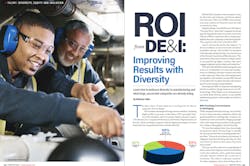ROI from DE&I: Improving Finances with Diversity
The data is there. It’s been there for a very long time. So why are companies slow to change?
The economic advantage of having a diverse workforce, including higher profits, is not news. As far back as 2007, non-profit women-in-the-workplace advocacy group Catalyst released a report, “The Bottom Line: Corporate Performance and Women's Representation on Boards,” which concluded companies with the highest percentages of women board directors outperformed those with the lowest by:
- 66% return on invested capital
- 53% return on equity
- 42% return on sales
Michael Bach, former deputy chief diversity officer for KPMG International and founder of the Canadian Centre for Diversity and Inclusion, notes that evidence of financial return has only increased since then.
Updated statistics from McKinsey’s 2019 report, “Diversity Wins,” shows that “companies in the top quartile of gender diversity on executive teams were 25% more likely to experience above-average profitability than peer companies in the fourth quartile. This is up from 21% in 2017 and 15% in 2014.”
And it’s not just the profits that improve. “A diverse workforce is more innovative and better at problem-solving,” says Carolyn Lee, president of the Manufacturing Institute, the research arm of the National Association of Manufacturers. “Research shows that a more inclusive workplace leads to increased hiring, higher retention rates, more engaged employees and an improved bottom line.”
With more than 800,000 manufacturing jobs open in the U.S. in September, Lee notes that manufacturers are looking to diversity to attract and retain a wider talent pool. More than 500 manufacturers participated in the Institute’s annual D&I Summit in December, 20221, to explore diversity and inclusion specific to the manufacturing workforce.
Knowing that DE&I is important and figuring out how to embrace change, however, are very different things. What follows is how manufacturers can think about diversity, advice on successfully implementing policies and examples of initiatives that work.
Evolving from Inclusive to Belonging
While companies have been moving, ever so slowly, to try to ensure that their workforce looks like the general population, including their customers, it’s nowhere near where it should be. Bringing in people with a wide range of characteristics be they gender, race, culture or geography is just the first step.
“It’s true that employers have been increasingly hiring diverse talent, but they forget to consider the environment that they are sending people into,” says Bach. “It has to be an inclusive environment. If employees don’t feel safe being who they are, they can’t thrive, let alone survive, and so they won’t stick around.”
This type of safety, referred to as psychological safety, means that employees need to feel that they can be their authentic selves, speak their minds and offer opinions without fear of any sort of retribution. This safety is really just a baseline. It’s when employees move from feeling safe to truly belonging that the deal is sealed. If an employee feels they are part of an organization, they will want to grow their career there, the thinking goes. That’s when the payoff hits since committed employees bring innovation, as well as continuous improvement to processes and products.
How does a company create a belonging culture? Bach offers some specific ideas.
Precise Policies and Procedures
The first step is to have deliberate action that is codified in policies and procedures. “Specific policies need to start with the hiring procedure. Is there a written policy with specific language to guide managers on hiring? Language is important,” explains Bach. “Are managers asking the same questions of each candidate or they are using their own judgment, which could bring in unconscious bias?”
As for the culture of the leadership that is making these decisions, it’s a bit more complicated. “From the top, leaders are trying to incorporate diversity in the organization, and at the bottom of the organization, employees want to see people who look like them. It’s the middle manager that’s caught in between. They are just trying to do their jobs and often have DE&I initiatives pushed into already busy schedules.”
Bach believes that these managers feel that they are promoting people on merit, but he’s concerned that their unconscious bias isn’t being examined. “Education on this needs to be mandatory, just like safety training is mandatory. It’s not something that everyone wants to explore,” says Bach. “A good idea would be to tie these DE&I metrics into performance reviews as people tend to care about what they are getting paid for.”
Measurement Is Tricky
Knowing how to measure diversity activities isn’t easy. “Just like we use engagement surveys, we need to use diversity surveys and be careful how we analyze the data. You need to slice and dice data by specific demographics. For example, if 80% of the people say that they feel valued at work, but when you divide the data into men and women and men answer yes to this at a 90% rate, but women are only at 65%, then you have a big problem. If you didn’t slice the data that way, you would be missing the issue.”
Continuing with this example, once you know women are not feeling part of the organization, what’s a company to do?
“Again, use data,” says Bach. “You can conduct focus groups, or one-on-one interviews to look behind the curtain and understand why women responded this way. If you hear the same story from a variety of people, then the problem is systemic.”
Often companies will ask people to self-identify when it comes to race and gender, but not everyone is willing to do that. For example, many companies create employee resource groups to build grassroots participation for a variety of groups, such as women, LGBTQ+, or veterans. While valuable, Bach says, “this type of structure tends to put the onus on the employees to do the heavy lifting. The procedures of inclusion should be ingrained in the culture of the company, not siloed into individual groups.”
Deliberate Action
To answer the oft-used comment for lack of diverse employees—that companies can’t find them—Bach says you need to change where you are looking. “If you just post ads on your website or go to the same places, you won’t get a different result. To find Black employees, spend time at HBCUs (historically Black colleges and universities). And when you do, be prepared to answer questions about how many Black executives you have. A good answer is, ‘We don’t have enough, and I’m here today because I want to change that.’”
Change isn’t easy, says Bach. “If you want to change you have to prepare for some discomfort. I pointedly say to my clients, ‘What are you going to do today to delivery on your targeted diversity goals; how are you going to make employees feel included enough to succeed?’”
Merely discussing the issues out in the open helps. Bach cites a report from Deloitte and the Victorian (Australia) Equal Opportunity and Human Rights Commission, “Waiter, is that Inclusion in my Soup?” from 2012 that found that “when employees think their organization is committed to and supportive of diversity and they feel included, they report better business performance in terms of ability to innovate (83% uplift) responsiveness to changing customer needs (31% uplift) and team collaboration ( 42% uplift).”
What Companies are Doing
Not everyone is pushing these surveys aside. The Manufacturing Institute has seen numerous companies that have specific programs:
- Dow recently committed to the Institute's 35x30 Campaign which aims to increase women’s representation in manufacturing to 35% by 2030. Dow has pledged to change perceptions by training more than 1,000 female mentors and helping them connect to younger women in the industry, four-year colleges and universities, community colleges and high schools.
- Pella’s “Go Beyond the Cause” Campaign includes a “Give it Up Challenge” that encourages employees to give up a guilty pleasure and instead donate to the campaign and “24 Hours of Thanks,” an event in which the company raised over $10,000 in one day.
- Arconic brought together various leaders and departments—including the management team, HR, communications, and the Arconic Foundation—to develop a program called Grow Together to spur action among employees as part of a collective initiative taking action on social justice issues in a way appropriate for them personally.
- Pfizer pledged to hire 500 refugees in the next three years as part of its Refugee Leadership Initiative, a program that includes providing coaching and support to these refugee employees to support their integration into the U.S. workforce.
A Bright Future
Employers are in a unique position to move the needle forward when it comes to improved DE&I status.
“Due to the controlled environment, companies can make DE&I provide education and training mandatory, just as they have regarding other issues such as discrimination,” says Bach. “The exciting part of that is that these culture changes expand outside the walls of the company. People take these ideas home to their families, and it ripples out to the world. As 60% of the global population are employees, that’s a huge impact.”
And once the workplace truly reflects the global population, we can eventually move away from viewing employees as part of specific groups. They will simply be valued employees. “We need to understand that diversity and inclusion is not the end goal. We need to see involving everyone as the way to run a successful business,” says Bach.

